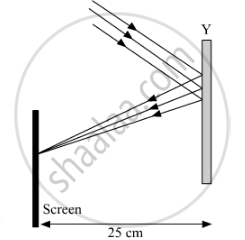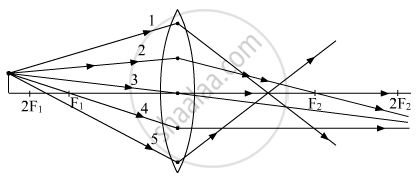Advertisements
Advertisements
प्रश्न
An object 5 cm in length is held 25 cm away from a converging lens of focal length 10 cm. Draw the ray diagram and find the position, size and the nature of the image formed.
उत्तर १
Given:
Object distance, u = −25 cm
Object height, ho = 5 cm
Focal length, f = +10 cm
According to the lens formula,
`1/v - 1/u = 1/f`
`1/v = 1/f + 1/u = 1/10 - 1/25 = 15/250`
`v=250/15=16.66` cm
The positive value of v shows that the image is formed at the other side of the lens.
Magnification m =`-"image distance"/"object distance"=-v/u = 16.66/25 = -0.66`
The negative sign shows that the image is real and formed behind the lens.
Magnification m =`"image height"/"object height" = "H"_i/"H"_o = "H"_i/5`
Hi = m × Ho= −0.66 × 5 = −3.3 cm
The negative value of the image height indicates that the image is inverted. The position, size, and nature of image are shown in the following ray diagram.

उत्तर २
Given:
Object distance, u = −25 cm
Focal length, f = 10 cm
Height of the object, h = 5 cm
Applying the lens formula, we get:
`1/f = 1/v - 1/u`
⇒`1/v = 1/f + 1/u`
⇒`1/v = 1/f + 1/u`
⇒`11/2/v = 1/10 + 1/-25`
⇒`1/v = (5 - 2)/50`
⇒ `1/v = 3/50`
⇒ v = `50/3`
⇒ v = 16.67 cm
The image will be at a distance of v cm behind the lens.
m = `"h'"/"h" = "v"/"u"`
⇒ `"h'"/5 = (50/3)/(-25)`
⇒ `"h'"/5 = 50/(3 xx -25)`
⇒ `"h'"/5 = 2/(-3)`
⇒ −3h' = 5 × 2
⇒ −3h' = 10
⇒ h' = `10/(-3)`
⇒ h' = – 3.33 cm
Size of the image: The image is smaller than the object. And the negative sign indicates that the image is real and inverted.
Nature of image: Real and inverted.
Ray diagram:

APPEARS IN
संबंधित प्रश्न
Study the given ray diagrams and select the correct statement from the following:


(A) Device X is a concave mirror and device Y is a convex lens, whose focal lengths are 20 cm and 25 cm respectively.
(B) Device X is a convex lens and device Y is a concave mirror, whose focal lengths are 10 cm and 25 cm respectively.
(C) Device X is a concave lens and device Y is a convex mirror, whose focal lengths are 20 cm and 25 cm respectively.
(D) Device X is a convex lens and device Y is a concave mirror, whose focal lengths are 20 cm and 25 cm respectively.
State any two uses of convex lenses.
Fill in the following blank with suitable word:
Parallel rays of light are refracted by a convex lens to a point called the ........
Describe with the help of a ray diagram the nature, size and position of the image formed when an object is placed in front of a convex lens between focus and optical centre. State three characteristics of the image formed.
A student did an experiment with a convex lens. He put an object at different distances 25 cm, 30 cm, 40 cm, 60 cm and 120 cm from the lens. In each case he measured the distance of the image from the lens. His results were 100 cm, 24 cm, 60 cm, 30 cm and 40 cm, respectively. Unfortunately his results are written in wrong order.
Which of the object distances gives the biggest image?
An object 50 cm tall is placed on the principal axis of a convex lens. Its 20 cm tall image is formed on the screen placed at a distance of 10 cm from the lens. Calculate the focal length of the lens.
How would a pencil look like if you saw it through How would a pencil look like if you saw it through
An image formed on a screen is three times the size of the object. The object and screen are 80 cm apart when the image is sharply focussed.
State which type of lens is used.
A teacher sets up the stand carrying a convex lens of focal length 15 cm at 42.7 cm mark on the optical bench. He asks four students A, B, C and D to suggest the position of screen on the optical bench so that a distinct image of a distant tree is obtained almost immediately on it. The positions suggested by the students were as
A. 12.7 cm
B. 29.7 cm
C. 57.7 cm
D. 72.7 cm
The correct position of the screen was suggested by
(a) A
(b) B
(c) C
(d) D
To find the image distance for varying object distances in case of a convex lens of focal length 15 cm, a student obtains on a screen a sharp image of a bright object by placing it at 20 cm distance from the lens. After that he gradually moves the object away from the lens and each time focuses the image on the screen.
(a) In which direction-towards or away from the lens does he move the screen to focus the object?
(b) How does the size of image change?
(c) Approximately at what distance does he obtain the image of magnification –1?
(d) How does the intensity of image change as the object moves farther and farther away from the lens?
Out of the five incident rays shown in the figure find the three rays that are obeying the laws of refraction and may be used for locating the position of image formed by a convex lens:
(A) 1, 2 and 3
(B) 2, 3 and 4
(C) 3, 4 and 5
(D) 1, 2 and 4
The image obtained while finding the focal length of convex lens is ....................
Where must a point source of light be placed in front of a convex lens so as to obtain a parallel beam of light?
The focal length of a lens is positive. In this case, state the kind of lens.
State the position of object, position of image, nature of image when: Convex lens is used as an erecting lens in terrestrial telescope.
An object is placed in front of a convex lens such that the image formed has the same size as that of the object. Draw a ray diagram to illustrate this.
Define the principal focus of a convex lens.
Which of the following statements is true?
Distinguish between Concave lens and Convex Lens.
Distinguish between:
Concave lens and Convex Lens
